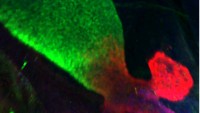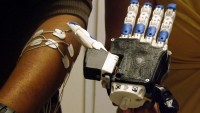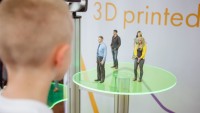3D-Printed Hearts Allow Doctors to Save Babies Lives
| Cory Doyle | | Nov 25, 2014 04:48 PM EST |
(Photo : OSF St. Francis Medical Center) The heart replicas are designed to match every tiny detail of a baby's heart.
3D printing technology can be used to create thousands of items ranging anywhere from houses to clocks and even clothes. They can even be used to save a baby's life by using the technology to create replicas of the human heart, according to new research.
Like Us on Facebook
Because babies have such tiny hearts, children who are born with some sort of heart defect usually first undergo a quick procedure to improve the flow of blood enough until the baby doubles in size. This typically takes at least six months before doctors perform complicated surgeries.
But even babies who have grown within the time still have very small hearts that are difficult to get a complete read on when looking at MRI scans.
This led pediatric cardiologist Dr. Matthew Bramlet and his colleagues at the University of Illinois College of Medicine to take detailed MRI scans and implement it into a design for a 3D printer to successfully create exact replicas of a baby's heart.
"The heart replicas are designed to match every tiny detail of a baby's heart, so they can help surgeons plan where to cut tissue, reroute piping and patch holes in children with congenital heart defects. The new findings were presented Nov. 19 at the American Heart Association meeting in Chicago," reports LiveScience.
Straight out of the gate, the replicated 3D printed hearts helped doctors make key surgical decisions that helped saved babies' lives.
The first case, doctors looked at an MRI scan and thought the baby's heart had only one hole in the wall of its ventricles that needed to be closed. However when looking at the 3D printed heart, doctors found that the baby's heart actually had multiple "Swiss-cheese-like" holes, which led them to chance their strategy going into the procedure.
Dr. Bramlet says that they've created nine heart replicas since the first repair and has drastically increased their understanding of the babies' heart defects heading into surgery. But the doctor also mentions it's just a small sample size and that more clinical trials should be set up to research more cases.
Tags3D Printing, Heart defects, save babies lives, children health, heart replicas, Surgery
©2015 Chinatopix All rights reserved. Do not reproduce without permission
 Zero Gravity 3D Printer Now Installed at the International Space Station
Zero Gravity 3D Printer Now Installed at the International Space Station Scientists Create 3D Printed Human Stomach Using Stem Cells
Scientists Create 3D Printed Human Stomach Using Stem Cells ESA Looks to 3D Printing to Build its First Moon Base
ESA Looks to 3D Printing to Build its First Moon Base Illinois Students 3D Print Smarter and Cheaper Prosthetic Hands
Illinois Students 3D Print Smarter and Cheaper Prosthetic Hands Print a Realistic 3D Copy of Yourself using Shapify
Print a Realistic 3D Copy of Yourself using Shapify- 3-D Printed Prosthetic Hand for Kids Looks Like Iron Man's
EDITOR'S PICKS
-

Did the Trump administration just announce plans for a trade war with ‘hostile’ China and Russia?
-

US Senate passes Taiwan travel bill slammed by China
-

As Yan Sihong’s family grieves, here are other Chinese students who went missing abroad. Some have never been found
-

Beijing blasts Western critics who ‘smear China’ with the term sharp power
-

China Envoy Seeks to Defuse Tensions With U.S. as a Trade War Brews
-

Singapore's Deputy PM Provides Bitcoin Vote of Confidence Amid China's Blanket Bans
-

China warns investors over risks in overseas virtual currency trading
-

Chinese government most trustworthy: survey
-

Kashima Antlers On Course For Back-To-Back Titles
MOST POPULAR
LATEST NEWS
Zhou Yongkang: China's Former Security Chief Sentenced to Life in Prison

China's former Chief of the Ministry of Public Security, Zhou Yongkang, has been given a life sentence after he was found guilty of abusing his office, bribery and deliberately ... Full Article
TRENDING STORY

China Pork Prices Expected to Stabilize As The Supplies Recover

Elephone P9000 Smartphone is now on Sale on Amazon India

There's a Big Chance Cliffhangers Won't Still Be Resolved When Grey's Anatomy Season 13 Returns

Supreme Court Ruled on Samsung vs Apple Dispute for Patent Infringement

Microsoft Surface Pro 5 Rumors and Release Date: What is the Latest?










